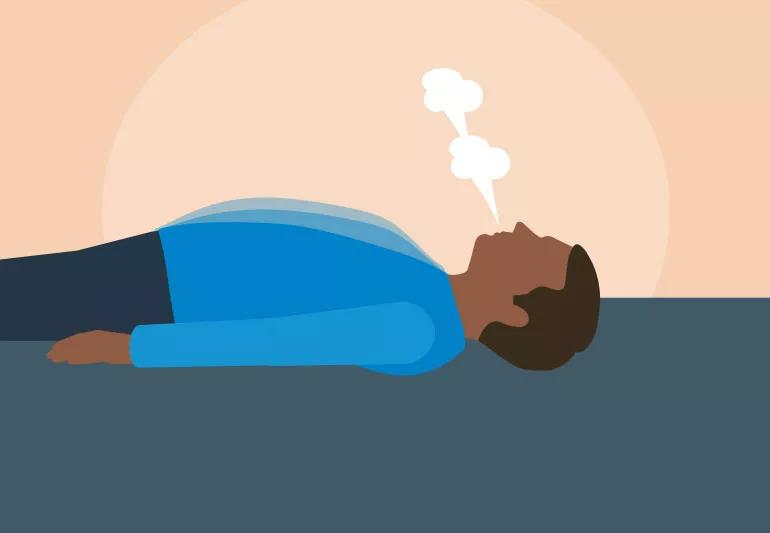This deep breathing technique can help you work through those big emotions

When you’re stressed out, a few deep breaths can do a world of good. Those cleansing breaths can put us at ease and help calm our worries and fears. Some forms of breathwork can even lead to greater self-awareness and a better outlook on life. One method that’s believed to lead to these results is known as holotropic breathwork.
Advertisement
Cleveland Clinic is a non-profit academic medical center. Advertising on our site helps support our mission. We do not endorse non-Cleveland Clinic products or services. Policy
So, what is it and how can you start breathing away stress and those big emotions? Behavioral health therapist, Jillian Williams, LISW-S, explains what holotropic breathwork is and shares how it can encourage us to deal with our feelings in healthier ways.
Stanislav Grof, MD, and his late wife Christina developed holotropic breathwork at the Esalen Institute in Big Sur, California in the 1970s. The Grofs’ background was in psychoanalytic therapy (talk therapy that focuses on bringing suppressed thoughts or feelings to the conscious mind) and they explored how altered states of consciousness could affect traditional counseling or therapy. Through their experiments, they found that rapid or deep breathing caused by panic or anxiety could affect the brain positively.
“The word ‘holotropic’ comes from the Greek words ‘holos’ or ‘whole’ and ‘trepein,’ which means ‘to move in the direction of something,’” says Williams. “Together, this means ‘moving towards wholeness.’” Williams says that holotropic breathing uses rapid, controlled breathing patterns to promote a dream-like experience, or what’s usually referred to as an “altered state of consciousness.” Once you reach this state, it’s possible to access parts of your consciousness that are hard to reach.
Advertisement
“The goal of holotropic breathwork is to essentially use accelerated breathing to increase awareness of the self as well as cope with traumas from the past. Holotropic breathwork allows you to access parts of your psyche that can’t be reached under normal conditions,” Williams explains.
She adds that it’s used to relieve mental health conditions and their symptoms, including:
According to Williams, the session begins with you lying down on a mat. Once you’re settled and comfortable, you’ll close your eyes and begin to breathe fast and deep in an even circular pattern. There are no pauses between inhales and exhales. While you’re doing this, feel free to make any movements or sounds that come naturally while continuing to keep your eyes closed. You might do this rapid breathing technique for minutes or even hours. Music is also played during the session to help you enter that altered state. You might hear drums or soft meditation melodies.
Holotropic breathwork practices are usually done in group settings but they can also be done one-on-one. In a group, a trained facilitator will oversee the session. Some people will breathe while others watch. The watchers are referred to as “sitters” and they’ll make sure that the “breathers” are comfortable and safe.
“During a holotropic breathwork practice, the most common experience is emotional release,” says Williams. “This might include waves of sadness, bursts of anger or shaking from fear. With the release of emotion can come slow, quiet tears or heavy sobbing.” She adds that the experience overall can either be an unnerving emotional roller coaster or extremely relaxing.
It’s the opposite. Williams says this type of breathwork can help dissolve unresolved emotions stored in your mind and body.
“As we grow up, we don’t always have the chance to develop the skillset needed to handle our feelings and emotions in healthy ways. And when feelings are not managed, they have a tendency to get suppressed in the body and can show up as muscle tension and burdens in the mind,” Willams says.
Holotropic breathwork gives people the opportunity to experience relief without conversation and because of that, it can be very helpful and healing for those who are living with trauma and anxiety.
Practitioners state that some benefits of holotropic breathing can include:
Advertisement
“Scientists have discovered that the rhythm of holotropic breathwork creates electrical activity in the human brain that enhances emotional judgment and memory recall,” says Williams. “Controlled breathing, when used to facilitate meditation, can cause a slight increase in brain size. The brain can also experience growth in areas that deal with attention and the processing of sensory input.”
Since holotropic breathwork may bring up intense feelings or strong physical and emotional releases, Williams strongly suggests talking to your healthcare provider before practicing it. You’ll want to avoid this type of breathwork if you have a history of:
Holotropic breathwork isn’t recommended for people who are pregnant or breastfeeding either.
“It is highly recommended that holotropic breathwork be used in conjunction with ongoing therapy as it offers an opportunity to work through and overcome any emotions or trauma that might surface. However, most people who practice it do not experience any adverse side effects from it,” assures Williams.
Advertisement
To hear more on this topic, listen to the Health Essentials Podcast episode, “Breathwork for Beginners.” New episodes of the Health Essentials Podcast publish every Wednesday.
Advertisement
Learn more about our editorial process.
Advertisement

Breathing, exercise, mindfulness and more can help you unwind and step away from your stress

From breath meditation to yoga nidra, all types of meditation aim to help you feel calmer, more relaxed and present

Different types of yoga poses, meditation and breathwork may help you feel more emotionally balanced

Sensory deprivation therapy can help relieve stress, improve sleep and decrease physical pain

You don’t need to have years of experience to reap the rewards of meditation — with benefits for your whole body, you only need a couple minutes to get started

While walking, be mindful of your body, your mind, your place in the world and all five of your senses as you pave a path forward, one step at a time

Thunder, waterfalls and heavy rain — these low-frequency sounds might help cancel out disruptive noises and thoughts

Immersing yourself in nature can improve both your mental and physical health

Babies can get congested easily, but you can calm their cough by keeping them hydrated, using nasal drops and running a humidifier

Weight loss may cause loose, sagging skin and muscle loss to your rear

Several conditions, like vitiligo and fungal infection, can cause a loss of pigmentation, leading to white spots or patches on your skin